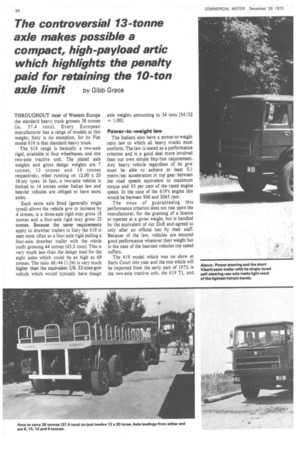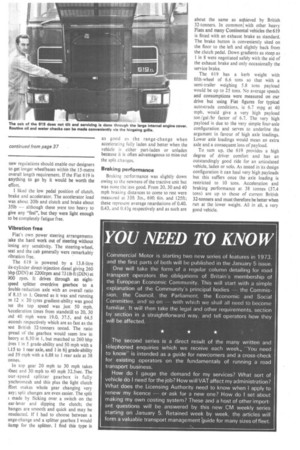The controversial 13-tonne axle makes possible a compact, high-payload artic which highlights the penalty paid for retaining the 10-ton
Page 38

Page 39

Page 43

If you've noticed an error in this article please click here to report it so we can fix it.
axle limit by Gibb Grace THROUGHOUT most of Western Europe the standard heavy truck grosses 38 tonnes (ie. 37.4 tons). Every European manufacturer has a range of models at this weight; Italy is no exception, for its Fiat model 619 is that standard heavy truck.
The 619 range is basically a two-axle rigid, available in four wheelbases, and one two-axle tractive unit. The plated axle weights and gross design weights are 7 tonnes, 13 tonnes and 19 tonnes respectively, when running on 12.00 x 20 18-ply tyres. In fact, a two-axle vehicle is limited to 14 tonnes under Italian law and heavier vehicles are obliged to have extra axles.
Each extra axle fitted (generally single tyred) allows the vehicle gvw to increase by 4 tonnes, ie a three-axle rigid may gross 18 tonnes and a four-axle rigid may gross 22 tonnes. Because the same requirements apply to drawbar trailers in Italy the 619 is seen most often as a four-axle rigid pulling a four-axle drawbar trailer with the whole outfit grossing 44 tonnes (43.2 tons). This is very much less than the design load for the eight axles which could be as high as 68 tonnes. The ratio 68/44 (1.54) is very much higher than the equivalent UK 32-tons-gcw vehicle which would typically have design axle weights amounting to 34 tons (34 /32 • =1.06).
Power-to-weight law The Italians also have a power-to-weight ratio law to which all heavy trucks must conform. The law is stated as a performance criterion and is a good deal more involved than our own simple bhp /ton requirement. Any heavy vehicle regardless of its gvw must be able to achieve at least 0.1 metre /sec acceleration in top gear ,between the road speeds equivalent to maximum torque and 93 per cent of the rated engine speed. In the case of the 619's engine this would be between 900 and 2045 rpm.
The onus of guaranteeing this performance criterion does not rest upon the manufacturer, for the granting of a licence to operate at a given weight, but is handled by the equivalent of our DoE and agreed to only after an official test by their staff. Because of the law, vehicles are ensured good performance whatever their weight but in the case of the heaviest vehicles top speed suffers.
The 619 model which was on show at Earls Court this year and the one which will be imported from the early part of 1973, is the two-axle tractive unit, the 619 11, and this is the model which I drove over a varied 50-mile route in Italy earlier this year. As tried, it was running in a form which is not legal in the UK as the axle loadings did not comply . In metric tonnes the axle loadings from front to rear were 6, 13, 13 and 6. The 13-ton axle loading makes this configuration unacceptable in all other European countries except France and Belgium, for eiswhere a lower maximumaxle limit makes an extra axle, either on the tractive unit or semi-trailer, necessary. In Britain. of course, it would be illegal to run at this weight without special authority regardless of axle weight.
Having said that, however, comments and results are relevant as the vehicle was running in its design configuration.
Cab comfort
The cab of the 619 is the same as that of the 684 described earlier (CM July 211972) and the same high standard of driver comfort described for the 684 applied to the 619 also. A suspension seat for the driver is a standard fitting on the 619 and has ample adjustments in all directions. While I found the seat itself comfortable enough I was not altogether happy with its suspension mechanism. The suspension of the 619 is so good I would say the best of any two-axle tractive unit I have driven, that the suspension of the seat was superfluous. Most of the time its suspension was unmoved but when it did depress over extremely rough ground (no equivalent roads expected to take 38-ton vehicles would be found in Britain) or when pulling on the mechanical handbrake I would have preferred a fixed seat. Long road springs with a large amount of deflection under load provided an excellent ride. Front springs of the 619 are 5ft 10in, long, the main rear springs 5ft 7th. and the higher rate helper springs at the rear 4ft 3in, long.
Double-action dampers are fitted to both front and rear axles and an anti-roll bar at the rear axle is standard. A drive of some five or six miles in the tractive unit as a solo machine impressed me even more, for it rode better than many laden two-axle rigid vehicles I have driven. The ride was obviously helped by the long wheelbase (131t 5in.) which is 3ft longer than the average British vehicle.
The typical shorter British wheelbase is to some extent caused by the influence of the since revised C and U Regulations. The new regulations should enable our designers to get longer wheelbases within the 15-metre overall length requirement. If the Fiat 619 is anything to go by it would be worth the effort.
I liked the low pedal position of clutch, brake and accelerator. The accelerator load was about 201b and clutch and brake about 3511, — although these were too heavy to give any "feel", but they were light enough to be completely fatigue free.
Vibration free
Fiat's own power steering arrangements take the hard work out of steering without losing any sensitivity. The steering-wheel, seat and the cab generally were remarkably vibration free.
The 619 is powered by a 13.8-litre six-cylinder direct-injection diesel giving 260 bhp (DIN) at 2200rpm and 7311b ft (DIN) at 900 rpm. It drives through an eightspeed splitter overdrive gearbox to a double-reduction axle with an overall ratio df 8.15 to I. Geared as it was and running )n 12 X 20 tyres gradient-ability was good )ut the top speed was just 50 mph. kcceleration times from standstill to 20, 30 tnd 40 mph were 19.0, 37.5, and 64.5 ;econds respectively which are as fast as the Jest British 32-tonners tested. The ratio ;pread of the gearbox would seem low in heory at 8.50 in 1, but matched to 260 bhp ;ives 1 in 5 grade-ability and 50 mph with a 1.15 to 1 rear axle, and 1 in 6-1grade-ability tnd 59 mph with a 6.88 to 1 rear axle at 38 onnes.
In top gear 20 mph to 30 mph takes 10sec and 30 mph to 40 mph 32.5sec. The our-speed splitter gearbox is fully ynchromesh and this plus the light clutch ffort makes whole gear changing very asy; split changes are even easier. The split 3 made by flicking over a switch on the ;ear-lever and dipping the clutch; the hanges are smooth and quick and may he treselected. If I had to choose between a ange-change and a splitter gearbox I would 'lump for the splitter. I find this type is
as good as the range-change when accelerating fully laden and better when the vehicle is either part-laden or unladen because it is often advantageous to miss out the split changes.
Braking performance
Braking performance was slightly down owing to the newness of the tractive unit but was none the less good. From 20, 30 and 40 mph braking distances to come to rest were measured at 33ft 3M., 69ft 6in. and 125ft; these represent average retardations of 0.40, 0.43, and 0.43g respectively and as such are about the same as aghieved by British 32-tonners. In commoni with other heavy Fiats and many Continental vehicles the 619 is fitted with an exhaust brake as standard. The brake button is conveniently sited on the floor to the left and slightly back from the clutch pedal. Down gradients as steep as 1 in 8 were negotiated safely with the aid of the exhaust brake and only occasionally the service brake.
The 619 has a kerb weight with fifth-wheel of 6.6 tons so that with a semi-trailer weighing 5,8 tons payload would be up to 25 tons. No average speeds and consumptions were measured on our drive but using Fiat figures for typical autostrada conditions, ie 6.7 mpg at 40 mph, would give a very high payload ton /gal /lir factor of 6.7. The very high payload is due to the very simple four-axle configuration and serves to underline the argument in favour of high axle loadings. Lower axle loadings would mean an extra axle and a consequent loss of payload.
To sum up, the 619 provides a high degree of driver comfort and has an outstandingly good ride for an articulated vehicle, laden or solo. As tested in its design configuration it can haul very high payloads but this suffers once the axle loading is restricted to 10 tons. Acceleration and braking performance at 38 tonnes (37.4 tons) are up to those of current British 32-tonners and must therefore be better when run at the lower weight. All in all, a very good vehicle.












































































